The Blue Horsehead Nebula is a reflection nebula located approximately 400 light-years away in the constellation Scorpius. It has the designation IC 4592 in the Index Catalogue. The nebula is illuminated by the multiple star system Nu Scorpii. The young blue star system appears as the eye of the horse.
Reflection nebulae like the Blue Horsehead are composed of clouds of interstellar dust that reflect the light of nearby stars. The energy of the hot blue stars in the Nu Scorpii system is insufficient to ionize the nebula’s clouds and make them emit their own light to produce an emission nebula. However, the starlight gives sufficient scattering to make the dust clouds visible.
The Blue Horsehead Nebula has a radius of 40 light-years and is part of a larger molecular cloud complex. The nebula appears very large in the sky, with an angular size of 150 by 60 arcminutes. The horse’s head only appears in long exposure photographs.
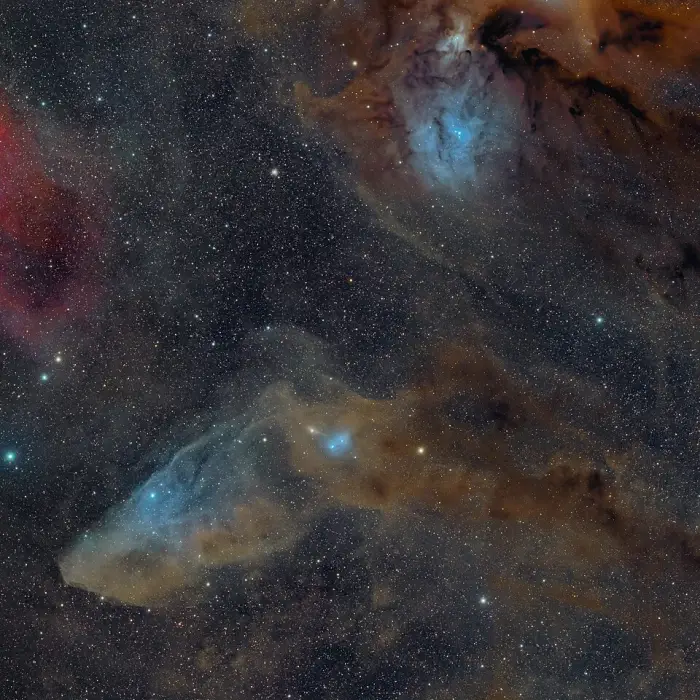
The Blue Horsehead Nebula (IC 4592), image credit: Giuseppe Donatiello (CC0 1.0)
The spectra of reflection nebulae are similar to those of the stars that illuminate them. These nebulae are most commonly blue because blue light gives more efficient scattering than red. The angular size of reflection nebulae depends on the apparent magnitude of the illuminating star. The fine dust in these objects would appear dark if not for the light of the energetic nearby stars.
Nu Scorpii, the source of the reflected light in the Blue Horsehead, is a multiple star system composed of about seven stars. The brightest components are massive, hot, blue B-type giants and main sequence stars. The seven stars are divided into two groups which can be resolved using a telescope.
The primary component in the system, formally known as Jabbah, is a main sequence star with the spectral type B3V. It has a mass 5.1 times that of the Sun and a radius of 6.52 solar radii. With a surface temperature of 13,400 K, it is 1,260 times more luminous than the Sun.
Jabbah shines at magnitude 4.349 from a distance of 470 light years. The star’s name is believed to be derived from the Arabic Iklīl al Jabhah, meaning “the crown of the forehead.”
Another reflection nebula, IC 4601, appears close to the Blue Horsehead. It surrounds a pair of relatively bright stars at the back of the horse’s head, near the horse’s ears.
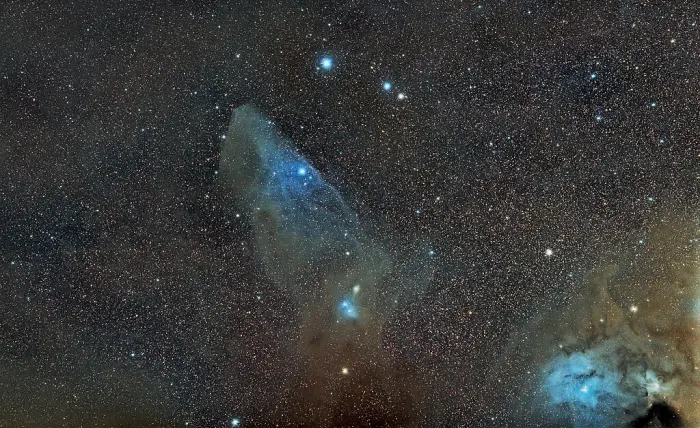
Blue Horsehead Nebula (IC 4592), credit: Wikimedia Commons/Cappellettiariel (CC BY-SA 4.0)
Facts
The Blue Horsehead Nebula was discovered by the American astronomer Edward Emerson Barnard on March 23, 1895. Barnard spotted the nebula on a photograph taken at Lick Observatory on Mount Hamilton in California.
IC 4592 was listed as Cederblad 128 (Ced 128) in Swedish astronomer Sven Cederblad’s Catalog of bright diffuse Galactic nebulae, published in 1946.
The Blue Horsehead Nebula is not the only horse in the sky. Others include the famous Horsehead Nebula, a dark nebula in the constellation Orion, and the Dark Horse Nebula (or the Prancing Horse) in Ophiuchus. The Horsehead Nebula lies on the opposite side of the sky, in the region of Orion’s Belt, while the Dark Horse Nebula appears in the same region as the Blue Horsehead, between the Scorpion’s claws and the Teapot in Sagittarius.
Jabbah is not the only star in this area of the sky to be surrounded by a diffuse nebula. Dschubba (Delta Scorpii), the middle bright star of the Scorpion’s claws, excites the emission nebula Sharpless 2-7 (Sh2-7). The bright Antares (Alpha Scorpii) at the Scorpion’s heart is surrounded by the emission nebula IC 4606, and the large reflection and emission nebula Sharpless 2-1 (Sh2-1) appears around the fainter Fang (Pi Scorpii).
Location
The Blue Horsehead Nebula is very easy to find because it appears in the region of the Scorpion’s claws, northwest of the bright orange star Antares. The nebula surrounds Jabbah, which appears just northeast of the brighter Acrab (Beta Scorpii). Acrab forms the brighter part of the Scorpion’s claws with Dschubba (Delta Scorpii) and Fang (Pi Scorpii). The three stars appear near Antares and are easy spot, even from moderately light-polluted areas.
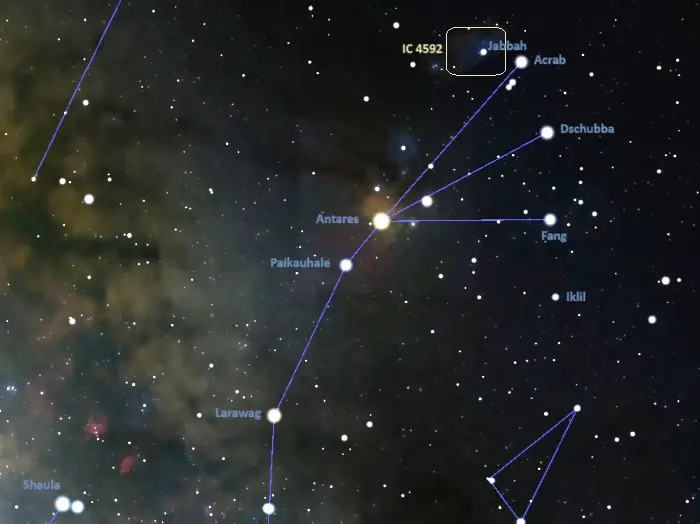
Location of the Blue Horsehead Nebula (IC 4592), image: Stellarium
The Blue Horsehead appears in the same area as the Rho Ophiuchi cloud complex, a large stellar nursery composed of bright and dark nebulae. The Rho Ophiuchi nebula is centred about 1 degree south of the massive blue multiple star system Rho Ophiuchi in the neighbouring constellation Ophiuchus. The vast cloud of gas and dust stretches across 4.5 by 6.5 degrees. It lies at a similar distance as IC 4592, approximately 460 light years away, and appears between the Blue Horsehead Nebula and Antares.
The Blue Horsehead Nebula, the Rho Ophiuchi cloud complex and the nebula around Pi Scorpii are a popular astrophotography target because they appear in the same wide field of view. Because of its faintness, the Blue Horsehead requires very dark skies and is best photographed using a LRGB filter. At declination -19° 27’, the nebula never rises for observers north of the latitude 70° N.
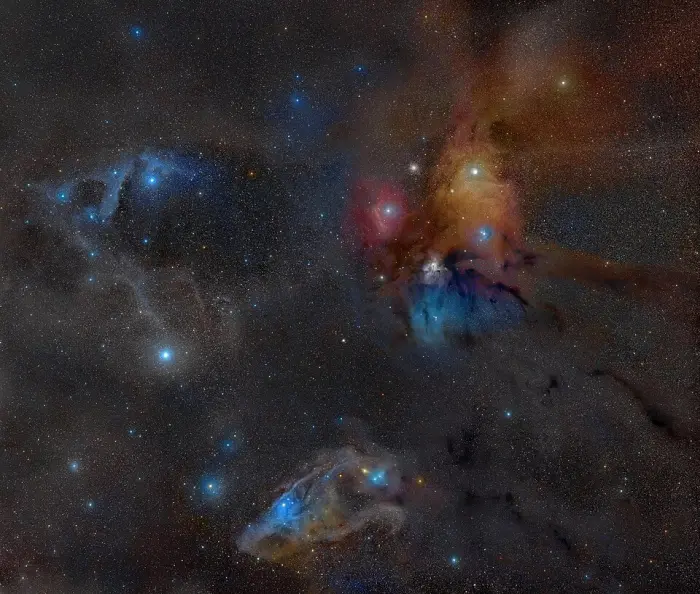
The binary star system Rho Ophiuchi. This star-forming region is located only 400 light years from Earth and is surrounded by a red emission nebula and numerous light and dark brown dust lanes. Nearby is the star Antares while the globular cluster, M4, is visible between Antares and the red emission nebula. Toward the bottom can be found IC 4592, the Blue Horsehead Nebula. Note: the stars in this image appear large and white rather than in their true colors due to overexposure, and the image is much more luminous than in reality (with normal computer screen settings). Antares is the white dot in the yellow area. North is towards the bottom. M4 is to the left of Antares, and Sigma Scorpii is to the lower left of M4, in the red area. These three objects form three corners of a pentagon. The other two corners, proceeding counterclockwise, are HD 147889 (near IC 4603) and 22 Scorpii. Far to the left of the pentagon is Pi Scorpii and lower down Dschubba and Acrab, three prominent stars in the head and claws of the Scorpion. The multiple star system Rho Ophiuchi itself appears as three white dots in the middle of the blue area just below the pentagon. Image credit: Rogelio Bernal Andreo (CC BY-SA 3.0)
The best time of the year to observe deep sky objects in Scorpius is during the month of July, when the constellation appears higher above the horizon in the early evening.
Blue Horsehead Nebula – IC 4592
| Constellation | Scorpius |
| Object type | Reflection nebula |
| Right ascension | 16h 11m 58.6s |
| Declination | −19° 27′ 17″ |
| Apparent size | 150’ x 60’ |
| Distance | 400 light-years |
| Radius | 40 light-years |
| Names and designations | Blue Horsehead Nebula, IC 4592, Cederblad 128, Ced 128, DG 132, LBN 1113, LBN 354.91+22.65, ESO 584-N*6 |
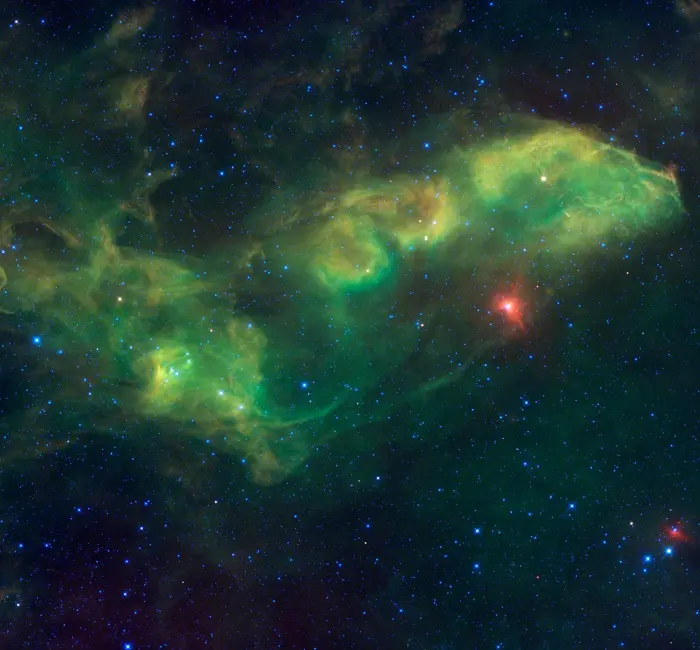
‘Jabbah is the name of the bright star right of center, surrounded by a red colored dust cloud. The Arabic name means “the forehead of the scorpion.” This view from NASA’s Wide-field Infrared Survey Explorer, or WISE, takes in an area of the sky in the constellation of Scorpius surrounding Jabbah, which is larger than a grid of eight by eight full Moons. Though Jabbah appears to be a single star, it is actually a whole system of stars (possibly as many as seven), each of which is many times more massive, larger, hotter and more luminous than the Sun. The Jabbah system is located about 440 light-years away from us and lights up a giant cloud of dust and gas near it. The cloud near Jabbah is designated IC 4592, and the portion farthest away to the far left in the image is IC 4601. The other bright stars in this image are mostly part of the “Upper Scorpius Association” and were probably once all born in the same cluster about 5 million years ago. These stars are all moving apart as the cluster ages, and are probably no longer bound to each other by gravity. Credit: NASA/JPL-Caltech/UCLA (PD)